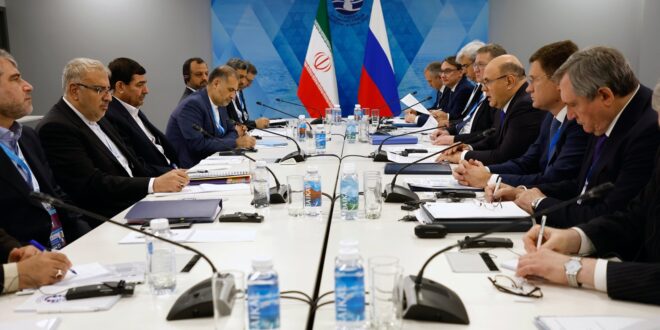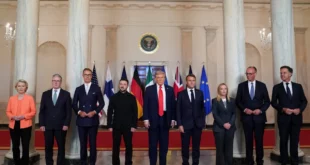Executive summary
In his article, Dr. Vali Kaleji, a Tehran-based expert on Central Asia and Caucasian Studies, postulates that banking and financial relations between Iran and Russia have developed significantly in recent years, which is unprecedented in the history of relations between the two countries. It seems that four factors have caused this development: the “Preferential Trade Agreement” (PTA) between Iran and the Eurasian Economic Union (EAEU) that is being upgraded to a Free Trade Agreement (FTA), the continuation of unilateral US sanctions against Iran and unclear perspective for reinstating the JCPOA, the pursuit of a “Neighbourhood Policy” and “Economic Diplomacy” by Iranian president Ibrahim Raisi, and the conflict in Ukraine and extensive Western sanctions against Russia.
It is clear that expanding trade without SWIFT, bank exchanges in rubles and rials between Iran and Russia and the elimination of the dollar require the creation of a new banking mechanism between the two countries. In this regard, the role of the Mir Business Bank branch of Bank Melli (National Bank) Iran in Russia has increased, the banking messengers of Iran (SEPAM) and Russia (SPSF), the Russian equivalent of SWIFT, have connected and the two countries are trying to integrate Russia’s Mir Payment System with Iran’s Shetab Banking System. For the first time, VTB Bank, the second largest bank in Russia, has opened an office in Tehran and two Iranian banks are going to open their branches in Russia.
However, financial and banking cooperation between Iran and Russia are suffering from challenges and constraints, including the commitment of Iranian exporters to the “cancellation of export obligation” inside of Iran, the price difference between the ruble rate used by Mir Business Bank and in the Iranian currency free market, the lack of stability in the ruble and rial exchange rate against the US dollar, as well as the disparity in the volume of imports and exports between Iran and Russia (1 to 4 in favour of Russia) and related difference in the volumes of the respective currencies used in bilateral trade. To overcome these challenges, the ruble purchase rate used by Mir Business Bank should be as close as possible to what’s used in the Iranian currency market, the two sanctioned countries should maintain exchange rate stability, and Russian companies can settle their financial claims by investing in Iran, so there is no need to transfer and exchange rials for rubles.
The banking and financial relations between Iran and Russia have developed significantly in recent years under the influence of several factors, which is unprecedented in the history of relations between the two countries. The first factor is the Preferential Trade Agreement (PTA) between Iran and the Eurasian Economic Union (EAEU) that was implemented on October 27, 2019, offering lower tariffs on 862 commodity types, of which 502 are Iranian exports to the EAEU. “This agreement significantly increased the trade volume between Iran and the member countries of the Union, including Armenia, Russia, Belarus, Kazakhstan and Kyrgyzstan. In the period between October 2019 and October 2020, the trade volume increased by more than 84%.” Since about 80% of Iran’s trade with the Union was related to Russia, it was clear that this new process required new financial and banking mechanisms between the two countries.
On the other hand, the PTA was designed to be in effect for three years; it was set to expire on October 5, 2022. For this reason, based on the Decision of the Supreme Eurasian Economic Council No. 16 of December 11, 2020, the parties have begun technical and expert negotiations to upgrade the PTA to a Free Trade Agreement (FTA). After two years, the technical and expert negotiations to upgrade this agreement to free trade between Iran and the EAEU ended in 2022, and it will most likely be implemented at the end of 2023. As a result of this new agreement, the number of goods subject to customs tariff reduction will increase from 850 to at least 8,000. It is obvious that the clear prospect of implementing the free agreement is not possible without expanding and facilitating financial and banking cooperation between Iran and Russia.
The second factor in the continuation of unilateral US sanctions against Iran is in the administration of Joe Biden. The unilateral sanctions imposed by the Donald Trump administration following the withdrawal of the United States from the Joint Comprehensive Plan of Action (JCPOA) on the Iranian nuclear programme in May 2018 led to a policy of “maxim pressure” and comprehensive sanctions against Iran. Iran’s oil exports and banking exchanges were worst affected by these sanctions. Although the policy of maximum pressure was practically stopped after Joe Biden came to power in January 2020, the sanctions against Iran remained. In particular, the SWIFT (Society for Worldwide Interbank Financial Telecommunication) embargo against Iran has remained a serious obstacle for international banking transactions.
In addition, efforts to revive the JCPOA did not come to fruition, and despite some limited and ad hoc agreements between Iran and the United States, including the exchange of prisoners and the release of some blocked funds, there are no clear prospects for reviving the JCPOA and returning to the state of affairs which existed before May 2018. It was clear that these conditions would push Iran towards “barter transactions” in trade and bank transactions with “national currencies”, especially with its neighbours, including Iraq (dinar) and Russia (ruble). It is clear that the bank exchange in rubles and rials between Iran and Russia and the elimination of the dollar requires the creation of a new banking mechanism between the two countries.
The third factor is the new policies and approach of Iranian president Ibrahim Raisi. When he came to power in August 2021, he declared a “Neighbourhood Policy” and “Economic Diplomacy” to be his administration’s top two foreign policy objectives. In this context, expanding relations with neighbouring countries Russia and China, upgrading the PTA to a Free Trade Agreement (FTA) between Iran and the EAEU, Iran’s full membership in the SCO and efforts to join BRICS would strengthen the “Neighbourhood Policy” and “Economic Diplomacy” that overlap with the “Look to the East Policy.” In all aforementioned issues, Iran is trying to create a financial and banking mechanism outside the SWIFT system. In the process, Iran hopes that by eliminating the dollar, it can develop foreign trade based on national currencies without being affected by unilateral US sanctions. Therefore, the development of banking and financial cooperation between Iran and Russia is a part of this process, which has been pursued by the Iranian government over the last two years.
The fourth factor is the conflict in Ukraine and the extensive related Western sanctions against Russia. In particular, “in late February 2022, a large coalition of states, including EU members, the US, Canada and the United Kingdom, among others, agreed to ban several Russian banks from SWIFT with the intent of economically isolating Russia and crippling its financial system,” according to Euronews. Under these circumstances, Russia turned to its own, newly-developed national interbank exchange system, the Financial Messaging System of the Bank of Russia (SPFS), which was first implemented in 2014 to replace SWIFT. During this time, Moscow tried to expand the SPFS to its BRICS partners (Brazil, India, China and South Africa), the EEU, the SCO and other countries it had maintained normal diplomatic ties with. In this endeavour, Moscow found a willing partner in Iran, especially with respect to bank transactions involving “national currencies” and developing an alternative payment system to SWIFT. Therefore, the expansion of banking and financial cooperation between the two countries was not unilateral from Tehran; Moscow also had important motives and interests in this field.
The meetings, negotiations and agreements between Iran and Russia in recent years clearly show the will and decision of the two countries to develop financial and banking cooperation. In particular, in January 2022, “Iranian President Ebrahim Raisi arrived in Moscow to discuss monetary and banking issues between Russia and Iran, and the two sides agreed to the removal of trade barriers to increase trade between one another to $10 billion per year.” Indeed, “during his time in Russia, Raisi said that Moscow and Tehran discussed measures on challenging the dominance of the US dollar and continuing trade between Russia and Iran in their respective national currencies.” Furthermore, when Russian President Vladimir Putin visited Tehran in July 2022, within the framework of the seventh summit of the heads of states of the Astana Peace Process for Syria, Supreme Leader Ayatollah Ali Khamenei emphasised that “the US dollar should be gradually taken off global trade, and this can be done gradually.” On the same day, in a symbolic act, trading occurred between the Russian ruble and Iranian rial on the Iran Currency Exchange, with the first trade occurring on July 19 with a 3 million Ruble ($48,000) exchange.
At the technical and expert level as well, the then-Governor of Central Bank of Iran (CBI), Ali Saleh-Abadi visited Moscow on July 8, 2022, where he met with Russian Deputy Prime Minister Alexander Novak, the country’s Minister of Economic Development Maxim Reshetnikov, the governor of Central Bank of Russian Federation, and senior directors of some major Russian banks. Additionally, the Governor of the Central Bank of Russia, Elvira Nabiullina, visited Iran on May 24, 2023, where she participated in the summit of the Asian Clearing Union (ACU) member states in Tehran. But beyond all these developments, what new events have happened in banking and financial cooperation between Iran and Russia?
The first important development is the increasing role of Mir Business Bank in banking cooperation between Iran and Russia. This bank, whose 100% shareholder is Bank Melli (National Bank) Iran, was established in January 2002 and started its operations in Moscow on April 15, 2002, with the permission of the Central Bank of Russia. In recent years, however, the role of this bank has been strengthened in the banking and financial exchanges between Iran and Russia. Its branches in Moscow have increased their presence and new branches have been established in Kazan and Astrakhan, two important centres of trade and business between the two countries.
Currently, the Mir Business Bank provides various banking services, especially to students and business professionals, including opening bank accounts for Russian resident and non-resident legal entities, crediting of funds in Russian rubles, Euro and Iranian rials, received from Iranian banks, transferring funds to other banks, including Iranian banks, in Russian Rubles, Euro and Iranian Rials and Issuing and advising LCs at the request of the customers of JSC “MB Bank” and/or other Russian and CIS banks for import purposes. Although the bank was among those financial institutions included in the US Treasury’s sanctions list in November 2018, as a branch of the National Bank of Iran, it already operates outside the SWIFT system. It was able to continue its activity facilitating banking cooperation between Iran and Russia, especially when Russia fell under Western sanctions following the start of the Ukraine conflict in February 2022.
The second critical step for Iran and Russia in further developing their financial and banking cooperation is the agreement to synchronise “the banking messengers”. In this regard, in January 29, 2023, the central banks of Iran and Russia signed a deal to connect their national interbank communication and transfer systems to help boost trade and ease two-way bank transactions. In fact, “since one of the preconditions of creating a SWIFT-like system between Iran and Russia is the development of native interbank messenger systems, this issue has also been a key part of expert and technical negotiations between the two countries,” according to the US-based Jamestown Foundation. In this regard, the banking messengers of Iran (SEPAM) and Russia (SPSF), the Russian equivalent of SWIFT, were connected in February 2023, and Sberbank and VTB Bank of Russia joined it.
By connecting the national messaging systems of Iranian and Russian banks, 700 Russian banks can exchange financial messages with Iranian banks.
The third development is the agreement to integrate Russia’s Mir Payment System with Iran’s Shetab Banking System. “Russia designed and created the Mir system in 2014, in addition to creating a financial system independent of SWIFT, as a way to overcome any potential blocking of electronic payments from systems designed by Western countries, such as Visa or MasterCard,” the Jamestown Foundation writes. Iran, meanwhile, established the Shetab Banking System in 2002, with the intention of creating a uniform backbone for the Iranian banking system. Based on these two banking infrastructures, Tehran and Moscow decided to integrate the Mir Payment System and the Shetab Banking System. However, the integration of Mir and Shetab has not yet been implemented due to technical difficulties and complications. Nevertheless, the two countries hope to implement this integrated system in the near future in order to facilitate ruble and rial-denominated financial and banking exchanges between Iran and Russia, outside the SWIFT system.
The fourth development, the opening of branches of Russian banks in Iran, was unprecedented. VTB Bank, the second largest bank in Russia, opened an office in Tehran on May 17, 2023. Deputy Governor of the Central Bank of Iran (CBI) for international affairs Mohsen Karim stated that “VTB Bank had been seeking to increase banking interactions with Iranian banks and we had asked the Central Bank of Russia to appoint VTB Bank as an ‘Agent Bank’ between two countries.” Also, in the near future, two Iranian banks are going to open branches in Russia, although the names of these two banks have not been announced yet. If this happens, in addition to Mir Business Bank, Iran will have two other bank branches in Russia, which will help speed up and facilitate banking and commercial exchanges between the two countries.
Despite the aforementioned developments, financial and banking cooperation between Iran and Russia continues to suffer from challenges and constraints. What are they and what suggestions are there to solve them? The first challenge is the commitment of Iranian exporters to the “cancellation of export obligation”, which was adopted by the Iranian government and the central bank. This decision was taken after the unilateral withdrawal of the United States from the JCPOA in May 2018, amid Washington’s pursuit of a policy of “maximum pressure” and comprehensive sanctions against Iran. In “cancellation of export obligation”, Iranian exporters commit to return the currency obtained from exports to Iran’s economic and banking system.
Since one of the methods of cancelling the foreign exchange obligation is selling the currency obtained from exports to Iranian banks, Iranian businessmen can sell the currency obtained from exports to Russia to Mir Business Bank. In fact, they sell rubles to Mir Business and receive the equivalent of rials from the Bank Melli (National Bank) Iran. However, due to the price difference between the ruble rate set by Mir Business Bank and the free-floating rate in the Iranian currency market, this process causes losses to Iranian traders and exporters and reduces their motivation to trade with Russia. This problem is also true in relation to money transfer, and for this reason many people prefer to transfer money through exchanges. To overcome this problem, the ruble purchase rate in the Mir Business Bank should be as close as possible to the prevailing rate in the Iranian currency market. Indeed, the establishment of new branches by Mir Business Bank, especially in St. Petersburg, can also help the development of trade and banking exchanges between Iran and Russia.
The second challenge is the lack of stability in the exchange rate of the ruble and the rial against the US dollar. An important point is that Iranian and Russian businessmen use the US dollar as the monetary base in their negotiations and agreements and after fulfilling obligations, they convert it into rubles and rials. Therefore, fluctuations in the exchange rate of the ruble and rial against the dollar often cause serious problems between the parties and it may cause serious damage to one of the parties to the contract. Although it is very difficult for Iran and Russia to maintain exchange rate stability as two countries under sanctions, relative stability in this field can help prevent losses caused by fluctuations in the exchange rate of the ruble and rial against the dollar.
The third, very important challenge is the disparity in the volume of imports and exports between Iran and Russia, which result in a mis-match in the sum of rials and rubles used in trade. The volume of trade between the two countries is $5 billion, of which almost $4 billion are Russia’s exports to Iran and almost $1 billion are Iran’s exports to Russia. So there is a ruble deficit, which is equivalent to $4 billion. Under these circumstances, the demand for rubles is very high, while Iran’s exports to Russia cannot provide this amount of rubles. To overcome this challenge, part of Russian exporters’ ruble claims from Iran can be used for investment in Iran. By this method, there is no need to transfer and exchange rials with rubles, and Russian companies can settle their financial claims via Foreign Direct Investment. Transit and transportation projects, Iran’s free economic zones such as Anzali Port, Amirabad Port and Chabahar, and the agricultural sector are among the suitable investment areas for Russian companies, which can provide the possibility of re-export for these companies to Russia and other countries.
 Eurasia Press & News
Eurasia Press & News




